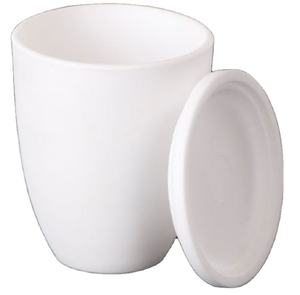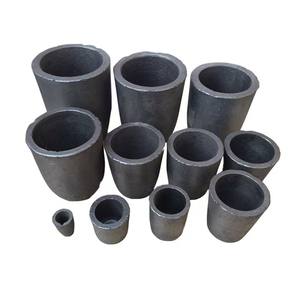Professional industry ceramic supplier, silicon nitride, silicon carbide, aluminum nitride and any other kinds of ceramics.
PRODUCT PARAMETERS
Description
Overview of Laboratory Ceramic Crucible for Melting Frit and Glass
Laboratory Ceramic Crucible for Melting Frit and Glass are specialized containers designed for withstanding extremely high temperatures in laboratory and industrial settings. They are essential for processes such as melting, calcining, and heat-treating a wide variety of materials, including metals, glasses, and chemicals. Our crucibles are engineered for superior thermal stability and chemical resistance, ensuring purity and reliability in the most demanding applications.
Features of Laboratory Ceramic Crucible for Melting Frit and Glass
-
Exceptional Thermal Shock Resistance: Withstands rapid temperature changes without cracking, ensuring durability and a long service life.
-
High-Temperature Stability: Maintains structural integrity at extreme temperatures, often exceeding 1500°C.
-
Excellent Chemical Inertness: Resists corrosion and reaction with molten metals, acids, and aggressive chemical fluxes.
-
High Purity & Low Contamination: Manufactured from premium materials to prevent sample contamination during sensitive processes.
-
Optimized Thermal Properties: Designed for efficient heat transfer and consistent performance in furnace environments.
-
Robust Mechanical Strength: Offers good resistance to physical impact and abrasion during handling and use.
Specifications of Laboratory Ceramic Crucible for Melting Frit and Glass
These laboratory ceramic crucibles deal with melting frit and glass. They need certain attributes. Crucibles are made from high-purity alumina ceramic. Alumina content is really high, commonly 99% or even more. This pure material withstands extreme heat. Crucibles withstand temperatures over 1700 ° C. They function well in kilns and furnaces. Thermal shock resistance is essential. Crucibles endure abrupt temperature level modifications without splitting. They warm up quick. They cool off quick. Chemical inertness is necessary. Crucibles withstand attack from molten frits and glasses. They stand up to solid changes. Crucibles do not react with the thaw. This keeps the melt pure. Crucible capabilities differ. Usual sizes are 10ml, 30ml, 50ml, 100ml, 250ml. Larger sizes like 500ml or 1000ml exist. Forms are normally typical cyndrical tubes. Tapered sides help putting. Some crucibles have putting spouts. These make emptying simpler. Crucible wall surfaces are thick enough. Thick walls provide strength. Thick walls make sure lengthy life. Smooth indoor surface areas are necessary. Smooth surfaces protect against thaw sticking. Smooth surface areas make cleaning easy. Crucibles are dense. High density quits thaw penetration. Crucibles stay strong over many usages. Optional lids are available. Covers lower heat loss. Covers stop contamination. Covers control evaporation. Crucibles come unglazed. Polishing is not needed. Crucibles last a very long time. They offer trustworthy efficiency for melting jobs.
Applications of Laboratory Ceramic Crucible for Melting Frit and Glass
Research laboratory ceramic crucibles are necessary tools for melting frit and glass. Individuals use them in many r & d settings. These crucibles stand up to high temperatures needed for melting glass. They are made from special ceramic products. These materials take care of severe heat extremely well. Ceramic crucibles are very important for glass formula work. Researchers melt batches of glass active ingredients inside them. They examine brand-new glass compositions this way. The crucible holds the liquified product securely. Frit melting is another typical application. Frit is a pre-melted glass combination. It obtains ground into powder for later use. Melting frit needs constant warm. Ceramic crucibles provide this secure atmosphere. Employees prepare tiny glass examples in these crucibles. They melt details amounts of basic materials. This assists research melting habits. The crucibles allow monitoring of the thaw. Scientists see exactly how the glass kinds and behaves. They look for bubbles or other concerns. These crucibles resist chemical attack from liquified glass. The glass does not easily stay with the ceramic surface area. This makes clean-up much easier after melting. Crucibles withstand unexpected temperature level adjustments also. They won’t split when warmed or cooled down swiftly. This thermal shock resistance is critical. It ensures crucibles last with many home heating cycles. Their sturdiness saves cash in time. Lab service technicians select particular ceramic kinds. Different ceramics provide numerous benefits. Alumina crucibles are really usual. They use excellent overall performance. Zirconia crucibles deal with even higher temperatures. They are excellent for demanding applications. Proper crucible option matters for successful melting. Take into consideration the melting temperature needed. Consider the glass structure. Consider the needed crucible size. These choices impact results.
Company Profile
Tanki New Materials Co.Ltd. focus on the research and development, production and sales of ceramic products, serving the electronics, ceramics, chemical and other industries. Since its establishment in 2015, the company has been committed to providing customers with the best products and services, and has become a leader in the industry through continuous technological innovation and strict quality management.
Our products includes but not limited to Aerogel, Aluminum Nitride, Aluminum Oxide, Boron Carbide, Boron Nitride, Ceramic Crucible, Ceramic Fiber, Quartz Product, Refractory Material, Silicon Carbide, Silicon Nitride, ect. please feel free to contact us.

Payment Methods
T/T, Western Union, Paypal, Credit Card etc.
Shipment Methods
By air, by sea, by express, as customers request.
5 FAQs of Laboratory Ceramic Crucible for Melting Frit and Glass
What material are these crucibles made from?
They are made from high-purity alumina ceramic. This material handles extreme heat well. It also resists chemical reactions better than many other ceramics. High alumina content makes them strong and durable for repeated melting cycles.
How hot can they get?
These crucibles can withstand very high temperatures. They are safe for continuous use up to about 1700°C (3092°F). They can handle short bursts even hotter than that. Always check the exact maximum temperature rating for your specific crucible size and type.
What sizes and capacities are available?
Crucibles come in many sizes. Common sizes range from small 10ml volumes up to large 500ml volumes or bigger. The right size depends on how much frit or glass you need to melt at once. Choose a size that fits your furnace and your batch needs.
What chemicals can they handle?
High-purity alumina resists many chemicals. It handles most common glass frits and fluxes well. Avoid using them with highly corrosive materials. Strong acids or alkalis can damage the ceramic over time. Check compatibility if unsure about your specific materials.
How should I handle them?
Handle these crucibles carefully. Thermal shock can crack them. Always preheat and cool them slowly. Avoid sudden temperature changes. Use proper tongs designed for ceramics. Inspect crucibles regularly for cracks or wear. Replace damaged crucibles immediately.
REQUEST A QUOTE
RELATED PRODUCTS
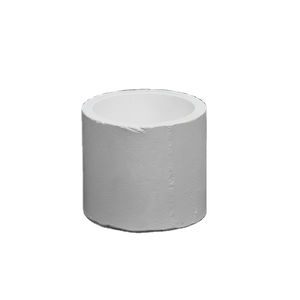
Alumina Ceramic and Zirconia Ceramic Labware Crucibles

1000g Quartz Glass Ceramic Platinum Melting Crucible Pot for Gold Silver Brass Platinum Smelting Refining
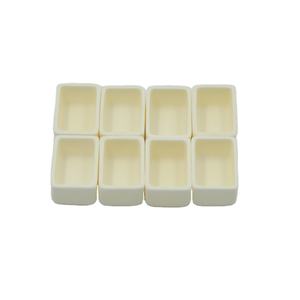
High Pure Quartz Ceramic Crucible for Furnace Melting Glass

High Purity Ceramic Crucibles Boron Nitride 99.7%
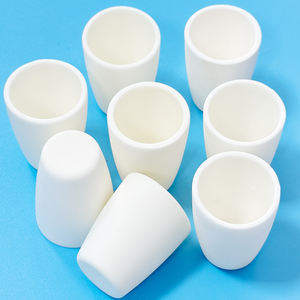
99% Alumina Boat Shape Ceramic Crucible with Hole or Not High Temperature Alumina Crucible
